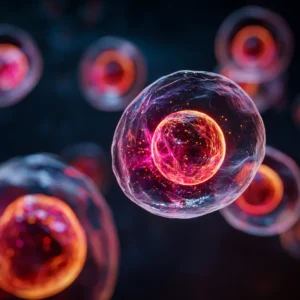There are several different types of stem cells and each works in a different way.
In this article, we explain the main types you’ll hear about from clinics and research so you can understand what they are, how they’re used, and what makes them different.
Mesenchymal Stem Cells (MSC’s)
Mesenchymal stem cells, or MSCs, are the most widely used type of stem cell that clinics use today.
Stem Cell Clinics around the world use them because they are relatively easy to obtain, can be grown and multiplied in a lab, and are known for their strong anti-inflammatory and immune-calming effects.
Where Do MSCs Come From?
- Bone marrow: MSCs are taken from the spongy tissue inside bones, usually from the hip.
- Adipose (fat) tissue: These cells are collected through a minor liposuction-style procedure.
- Umbilical cord tissue: After birth, the umbilical cord can be donated. The richest source of MSCs here is Wharton’s Jelly. The soft, gelatin-like tissue that cushions the cord’s blood vessels. Wharton’s Jelly stem cells are young, highly active and generally well tolerated even when given to another person.
Why Are MSCs So Popular?
MSCs are commonly used in stem cell therapy because they:
- Calm harmful inflammation in the body.
- Modulate the immune system, preventing it from overreacting.
- Support natural repair by releasing growth factors and healing signals.
Most current clinic-based therapies whether for arthritis, autoimmune conditions, or degenerative diseases use MSCs as their primary cell type.
To read more about how these cells are used in treatment today, our article on how Stem Cell Treatment works explains it in more detail.
Looking into how Stem Cell Treatments actually work? Our team can walk you through how it works for your specific condition, costs & options across countries.
Get Free GuidanceNo pressure. No spam. Just honest advice to help choose the right clinic.
What’s the difference between MSC Cells from Bone Marrow, Fat Tissue & Umbilical Cord?
Even though bone marrow, adipose tissue, and umbilical cord all give us mesenchymal stem cells, the cells aren’t identical.
They can behave differently depending on where they come from. Here’s how it breaks down:
Bone Marrow MSCs
- One of the earliest and most studied sources of MSCs.
- Tend to show stronger potential for forming bone, cartilage and connective tissue.
- Commonly used in orthopedic treatments such as arthritis, cartilage defects, and tendon injuries.
Limitation: MSC numbers and potency decline with age, which can make autologous bone marrow harvests less effective in older patients, if treatments aren’t cultured.
Adipose (Fat) MSCs
- Harvested through a small liposuction procedure, yielding a very high number of cells compared to bone marrow.
- Known for strong anti-inflammatory and immune-modulating effects, making them attractive for autoimmune or systemic conditions.
- Increasingly studied in arthritis and sports medicine, with good results for pain and function.
Limitation: They are less studied than bone marrow MSCs when it comes to structural regeneration (e.g., rebuilding cartilage or bone).
Umbilical Cord / Wharton’s Jelly MSCs
- Collected after birth (non-invasive, ethical donation).
- Very young and potent, with high ability to multiply in the lab.
- Considered immune privileged → low risk of rejection.
- Increasingly used in clinical trials and private clinics for neurological, autoimmune, and systemic conditions.
Ethical & Safety Issues Around Umbilical Cord–Derived MSCs
Consent & commercialization
Cords are donated after birth, usually with informed consent from the mother.
In well-regulated systems, parents aren’t paid, donation is voluntary.
But in loosely regulated markets, there are concerns about commodification (cords being bought from vulnerable mothers in low-income settings).
Screening & testing
Proper cord tissue banking requires rigorous infectious disease screening (HIV, hepatitis, syphilis, CMV, etc.) for both mother and cord tissue.
Labs must test for sterility, contamination and ensure quality control before expansion.
In less-regulated settings, poor or absent screening is a real risk, leading to patient safety issues.
Variability in quality
Even when safe, the potency of cord MSCs varies depending on how they’re collected, processed and expanded.
Some clinics may not disclose whether they’re using fresh, minimally processed cells versus lab-expanded, cryopreserved, or pooled donor cells.
Regulatory oversight
In the US and EU, umbilical cord MSCs are tightly regulated as an “advanced therapy medicinal product (ATMP).” They cannot be marketed as same-day “stem cell injections.”
In many developing countries, oversight is much weaker, which is why you see wide variation in practices.
This is one of the reasons it’s so important to choose a clinic that’s undergoing the correct procedures when sourcing their umbilical cord derived MSC’s. If clinics aren’t testing correctly, it could be extremely dangerous. That’s why we take our vetting process so seriously.
Hematopoietic Stem Cells (HSCs)
Hematopoietic stem cells are the stem cells that make all of the body’s blood and immune cells. They are found in bone marrow, peripheral blood, and umbilical cord blood. HSCs are best known for their use in hematopoietic stem cell transplants (HSCT), sometimes called bone marrow transplants. This is one of the oldest and most established stem cell therapies in medicine, and it has been saving lives for decades.
Where Are HSCs Used?
HSCT is a standard of care for:
- Blood cancers: such as leukemia, lymphoma and multiple myeloma.
- Bone marrow failure disorders: like aplastic anemia.
- Severe immune system disorders: where “resetting” the immune system is necessary.
- Multiple sclerosis (MS): HSCT can wipe out and rebuild the immune system, leading to long-term remission in some aggressive cases. (Read our MS Research Article)
- Rheumatoid arthritis (RA): In highly treatment-resistant RA, HSCT has been tested as a way to reboot the immune system when conventional therapies fail.(Read our RA Research Article)
- Other autoimmune diseases: Research has explored HSCT for severe conditions like Crohn’s disease and systemic sclerosis when standard treatments don’t work.
How Does It Work?
1. Patients usually receive high-dose chemotherapy or radiation to destroy the diseased or malfunctioning bone marrow.
2. Healthy HSCs (from the patient’s own body or a donor) are then infused into the bloodstream.
3. These cells travel to the bone marrow, where they engraft permanently and begin producing new, healthy blood and immune cells.
Why It Matters
Unlike many newer stem cell therapies that are still experimental, HSCT is an approved, widely used medical treatment with clear protocols and decades of follow-up data. It shows that stem cells are not just a “future promise”. In some cases, they are already established medicine.
Embryonic Stem Cells (ESCs)
Embryonic stem cells are pluripotent, which means they can become any cell type in the body.
In theory, this makes them one of the most powerful tools in regenerative medicine. However, their use is mostly limited to research settings because of ethical concerns and strict regulations in many countries.
Where Are ESCs Being Used in Research?
Although not widely available in clinics, ESC-derived cells are being studied in several advanced clinical trials:
- Type 1 Diabetes: ESCs are grown into insulin-producing islet-like cells. Early human trials (e.g., ViaCyte, Vertex) show that transplanted cells can produce insulin, reducing the need for daily injections. But patients often need immunosuppressant drugs to prevent rejection. (Read about Vertex on their press release and Viacyte on their clinical trials page)
- Parkinson’s Disease: ESCs have been used to create dopaminergic neurons, with ongoing trials testing whether these cells can restore dopamine production and improve movement symptoms. (Read about S.Biomedics ESC Trial on their clinical trials page and more research on our Parkinson’s Research Article)
- Spinal Cord Injury: Research has transplanted ESC-derived neural cells into the spinal cord to test whether they can integrate and support motor recovery. Safety has generally been acceptable, though results are still preliminary. (Read about Lineage’s Clinical trial on their press release)
Why ESCs Are Not Widely Available Yet
- Ethical concerns: ESCs are derived from early-stage embryos, which raises moral and legal debates in many countries.
- Safety concerns: In animal studies, undifferentiated ESCs have been shown to form tumors (teratomas). While modern human trials using carefully pre-differentiated ESC-derived cells have not reported tumors, regulators remain cautious.
- Regulatory barriers: Because of these ethical and safety issues, most countries restrict ESC use to tightly controlled research studies, not routine clinical care.
Induced Pluripotent Stem Cells (iPSCs)
Not sure which country’s right for you?
Browse verified stem cell clinics in Colombia, Japan, Thailand and more that we’ve already personally vetted.
Browse Verified Stem Cell ClinicsInduced pluripotent stem cells are created by taking ordinary adult cells, such as skin or blood cells and “reprogramming” them back into a pluripotent state.
Like embryonic stem cells, they can theoretically become any cell type in the body.
Why iPSCs Matter
- Avoid ethical issues: Unlike embryonic stem cells, iPSCs don’t come from embryos, which makes them less controversial.
- Patient-specific potential: In theory, iPSCs could be made from a patient’s own cells, reducing the risk of rejection.
- Active global research: Japan and the US are leading clinical research programs using iPSCs for several conditions.
Where Are iPSCs Being Studied?
Based on current trials and the research in our library:
- Type 1 Diabetes: iPSCs are differentiated into insulin-producing islet cells. Early studies show transplanted cells can produce insulin, reducing the need for injections though many patients still need immunosuppressants to protect the graft.(Read about the real world case study on Cell)
- Spinal Cord Injury (SCI): Japanese trials have transplanted iPSC-derived neural progenitor cells into the injured spinal cord. Results show safety so far, with some patients regaining partial motor or sensory function. (read the case study in Keio University Hospital on their press release)
- Parkinson’s Disease: iPSCs are being turned into dopaminergic neurons, the brain cells lost in Parkinson’s. Ongoing human studies in Japan are testing whether these cells can restore dopamine production and improve movement symptoms. (read about XellSmart’s trial on their clinical trials page & on our Parkinon’s Research Article)
- Macular Degeneration (AMD): Japan launched the world’s first iPSC-based eye cell transplant in 2014. Today, most AMD trials use iPSC-derived retinal pigment epithelial (RPE) cells, which aim to replace damaged retinal tissue and slow or restore vision loss. (Read about Luxa Biotech’s iPSC trial in their press release & more trials on our AMD Research Page)
Why iPSCs Aren’t in Clinics Yet
- Safety: Like embryonic cells, iPSCs carry a risk of forming unwanted tissue if not fully controlled.
- Complexity: Manufacturing personalized iPSC therapies is time-consuming and expensive.
- Regulation: Most countries restrict iPSCs to research use until more long-term safety data is available.
- Read our full article on Induced Pluripotent Stem Cells here
Fetal Stem Cells
Fetal stem cells are taken from tissue in early-stage pregnancies (usually aborted fetuses). Unlike umbilical cord stem cells, which are donated after birth, fetal cells are harvested during gestation. They are more developed than embryonic cells but still have strong growth and regenerative potential.
Some private clinics, particularly in places like Ukraine and parts of Eastern Europe advertise fetal stem cell therapies for a wide range of conditions, from neurological diseases to anti-aging treatments. These treatments are not part of mainstream, regulated medicine, and most have not been tested in large clinical trials.
- Ethical concerns: Because the cells come from aborted fetuses, fetal stem cell use raises major moral and legal debates.
- Safety issues: Unlike regulated cord or bone marrow programs, fetal stem cell treatments offered in private clinics may lack proper screening, testing, or quality control, raising risks of infection or abnormal growth.
- Scientific uncertainty: While fetal stem cells are biologically powerful, there is limited clinical data to show they are more effective than other cell sources like MSCs.
Fetal stem cell therapy is largely unregulated and remains controversial worldwide. Patients considering treatment in countries where these therapies are offered should ask very direct questions about:
- How the cells are sourced.
- What safety testing is performed.
- Whether the therapy has published, peer-reviewed clinical results.
Neural Stem Cells (NSCs)
Neural stem cells (NSCs) are specialized stem cells that can develop into the main cell types of the nervous system: neurons, astrocytes, and oligodendrocytes.
Because they are already “pre-programmed” for the brain and spinal cord, researchers believe they may be more effective than general stem cells like MSCs for neurological repair.
Where Are They Being Studied?
Neural stem cells have been investigated in several neurological conditions:
- Parkinson’s disease: Research trials have tested neural stem cell transplants to restore dopamine-producing neurons that are lost in the disease. Some early studies showed motor improvements, though results were inconsistent. (read a review done in China looking at Neural Stem Cells for Parkinson’s on BioMed Central)
- Spinal Cord Injury (SCI): NSCs have been transplanted into injured spinal cords in clinical studies to see if they can replace lost neurons and support repair. Early results suggest safety, with hints of sensory and motor recovery in some patients. (You can read about Seneca Biopharma’s phase 1 Neural Stem Cell trial on Cell & more studies on our SCI Research Article)
- Traumatic Brain Injury (TBI): Pilot studies are testing whether NSCs can help repair damaged brain tissue, though this research is still in very early stages. (You can read a review done on Italy looking at Neural stem cells for TBI here)
Challenges and Risks
- Safety: NSCs need to integrate correctly into the nervous system; otherwise, there is a risk of abnormal growth or poor function.
- Consistency: Human studies so far have shown mixed results, with some patients improving and others showing little change.
- Regulation: Most NSC therapies remain experimental and are only available in tightly controlled clinical trials.
Why They Matter
Neural stem cells represent one of the most targeted approaches for brain and spinal cord repair, since they are naturally designed to become neural tissue.
While still experimental, they highlight the future direction of regenerative neurology, especially as technologies like iPSCs make it possible to generate neural stem cells in the lab in a safer, more controlled way.
If you’re deciding which country is best for you, or want to talk about clinics we’ve already vetted, fill out our form below. Our team will guide you with clear, honest answers.
Alt Treatment is a free, independent platform that helps you understand stem cell therapy & decide if it’s right for you.
We break down complex information into clear, honest guidance. When you’re ready, we can connect you with verified clinics that meet your needs, in the right location & often with exclusive discounts.
There’s no charge to use our platform. No hidden fees. No pressure. Our main aim is to genuinely help you figure out if treatment is right & the best places to consider.
If you want to talk, fill out our form here & our personal concierge team will reach out.
Stem cell therapy works mainly by releasing signals that reduce inflammation, calm the immune system, and stimulate the body’s own repair processes, rather than the cells permanently becoming new tissue.
To go into more detail, our article on What is Stem Cell Therapy explains the full process.
If you’re looking into clinics, you can compare all the clinics we’ve personally vetted around the world on our Find a Clinic Page.
Most Common countries people get treatment from are Colombia, Mexico, Panama, Thailand, India & Japan. People get treatment from the US too. But there’s differences in each region, check out our article on treatment in different countries here.
Fill in your details below
For a discounted offer for Stem Cell Therapy!






